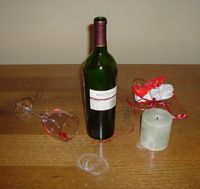

 The Party's Over
The Party's Over
A call that I get very often after the holidays is "How do I get candle wax off my prized antique piece of furniture?" or "I have a spot on my table that won't go away". Fortunately, minor damage can often be treated without too much trouble. Below are a few simple tips for repairing common blemishes in wood furniture. However, if your piece is particularly valuable or the damage is severe, you may want to consult a furniture restoration specialist before attempting these or other repairs.
Wax:
A simple and easy way to remove wax is to apply mineral spirits with a soft rag and rub gently until the wax is completely dissolved. It can then be wiped off with a
clean soft cloth
. After this a cloth with a little soapy water should be used to clean off the residue, and then the surface should be wiped clean with a dry soft cloth.
Alcohol:
Alcoholic beverages, on the other hand, pose an entirely different problem when left to dry on a finished surface.
Since alcohol dries at such a fast rate it creates a great deal of heat. The effect this has on lacquer and varnish finishes is usually a "fume spot" where the finish appears very dull and flat. To bring the shine back it generally takes a little wet sanding with a special type of sandpaper known as "wet-dry" sandpaper.
3M Imperial WetorDry sandpaper
is available in super-fine grits from 1000-2500 that are great for rubbing out or polishing finishes.
This type of paper is made of smooth-cutting silicon carbide and is used wet with soapy water or mineral spirits as a lubricant. It will make very quick work of sanding the finish, so go easy. Be sure to sand in the direction of the wood grain. After a light sanding the finish can then be polished back to its original luster using a polishing compound such as
Behlen Rottenstone
mixed with any paste wax, or
Meguiar's Swirl Remover
.
If the overall finish has a satin or dull appearance, use
#0000 steel wool
or a
white Scotch-Brite pad
after sanding to rub out the area to match the existing finish. However, never attempt to bring a gloss finish back to its original polished sheen using this method, as even the finest steel wool will scratch too deeply for polishing compounds to rub out the scratches on the surface. On glossy surfaces it is best to use a polishing compound with a high-speed rotary buffer.
If the finish happens to be shellac, the alcohol will have melted the finish and probably created quite a mess. If this is the case, then the finish has to be wet-sanded flat and more shellac applied either by brush or using the
French polishing
method.
Water Spots or Rings:
White spots or rings caused by water are sometimes easy to remove if they are very close to the surface. White spots are caused when gravity pulls the water into the porous surface and evaporates into a cloud you then see as a white spot or ring. If the damage is close to the surface, a light heating with a hair dryer THAT IS CONSTANTLY MOVING BACK AND FORTH and held at least 12 inches away from the surface may expand the finish enough to release the cloud. Don't use too much heat, or it may bubble the finish.
If this doesn't do the trick, the next method would be to apply petroleum jelly (Vaseline) to the spot and let it sit for at least 12 hours. Wipe this off with a soft cloth lightly dampened with mineral spirits, and then wipe dry with a clean soft cloth.
Liberon Ring Remover
will also remove most white water spots and rings as well as heat marks on most highly polished surfaces including French polishes, lacquers, varnishes and other modern hard finishes.
Tips: